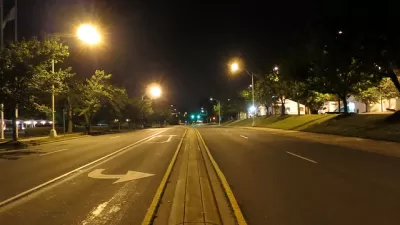Comparing wide versus narrow lanes, Kenneth A. Small and Chen Feng Ng examine the relatively unexplored design of building more compact roads to alleviate traffic congestion.
The U.S. Interstate Highway System has strict design standards that theoretically provide safe travel at high speeds, but only off-peak drivers have the opportunity to travel at high speed on these expressways. Small and Ng say, "But suppose we can design new roads, or reconfigure existing roads, to have lower speeds, neighborhood-friendly footprints, and higher capacity." For example, the standard 12-foot-wide lane is considered safe for mixed traffic at high speeds, but Small and Ng propose a road of the same total width with narrower lanes and shoulders. This would allow for more lanes to increase capacity, which means peak travelers can drive faster.
Small and Ng take a closer look at wide versus narrow lanes by comparing Expressway R of Interstate standards with Expressway C of a more compact design. They find that R has a higher free-flow speed (65.5 mph) than C (60.4 mph) under light traffic conditions, but as traffic volume increases, the decline in speed occurs more quickly on R with its fewer lanes. This was the same result when measuring average travel times. "Repeating these calculations at different traffic levels and peak-to-off-peak ratios," confirm Small and Ng, "we find the compact design performs better under all conditions in which there is appreciable queuing." The reason is that compact design depends on traffic volume, whereas regular design depends on free-flow speeds.
As for safety considerations, "it is uncertain whether the compact road design will reduce or increase safety." Wider lanes are generally regarded as safer because they provide leeway if drivers wander from their lane or swerve to avoid an accident, but there is no strong empirical evidence. "The most important factor is likely the speed chosen by drivers, which suggests a policy response," say Small and Ng. "reduce the speed limits on compact roads and add other measures to discourage speeding."
FULL STORY: When Do Slower Roads Provide Faster Travel?

Planetizen Federal Action Tracker
A weekly monitor of how Trump’s orders and actions are impacting planners and planning in America.

Maui's Vacation Rental Debate Turns Ugly
Verbal attacks, misinformation campaigns and fistfights plague a high-stakes debate to convert thousands of vacation rentals into long-term housing.

Restaurant Patios Were a Pandemic Win — Why Were They so Hard to Keep?
Social distancing requirements and changes in travel patterns prompted cities to pilot new uses for street and sidewalk space. Then it got complicated.

In California Battle of Housing vs. Environment, Housing Just Won
A new state law significantly limits the power of CEQA, an environmental review law that served as a powerful tool for blocking new development.

Boulder Eliminates Parking Minimums Citywide
Officials estimate the cost of building a single underground parking space at up to $100,000.

Orange County, Florida Adopts Largest US “Sprawl Repair” Code
The ‘Orange Code’ seeks to rectify decades of sprawl-inducing, car-oriented development.
Urban Design for Planners 1: Software Tools
This six-course series explores essential urban design concepts using open source software and equips planners with the tools they need to participate fully in the urban design process.
Planning for Universal Design
Learn the tools for implementing Universal Design in planning regulations.
Heyer Gruel & Associates PA
JM Goldson LLC
Custer County Colorado
City of Camden Redevelopment Agency
City of Astoria
Transportation Research & Education Center (TREC) at Portland State University
Jefferson Parish Government
Camden Redevelopment Agency
City of Claremont




























